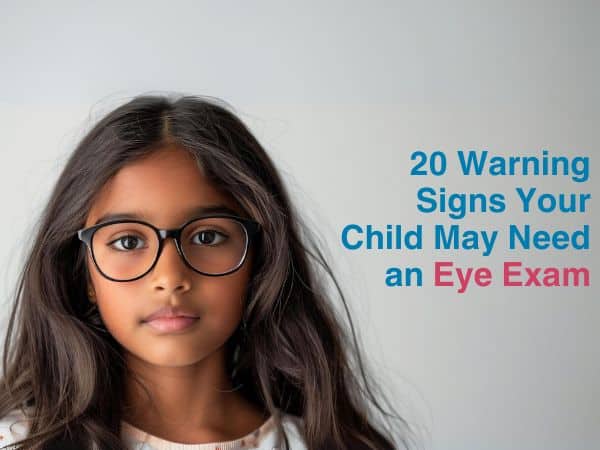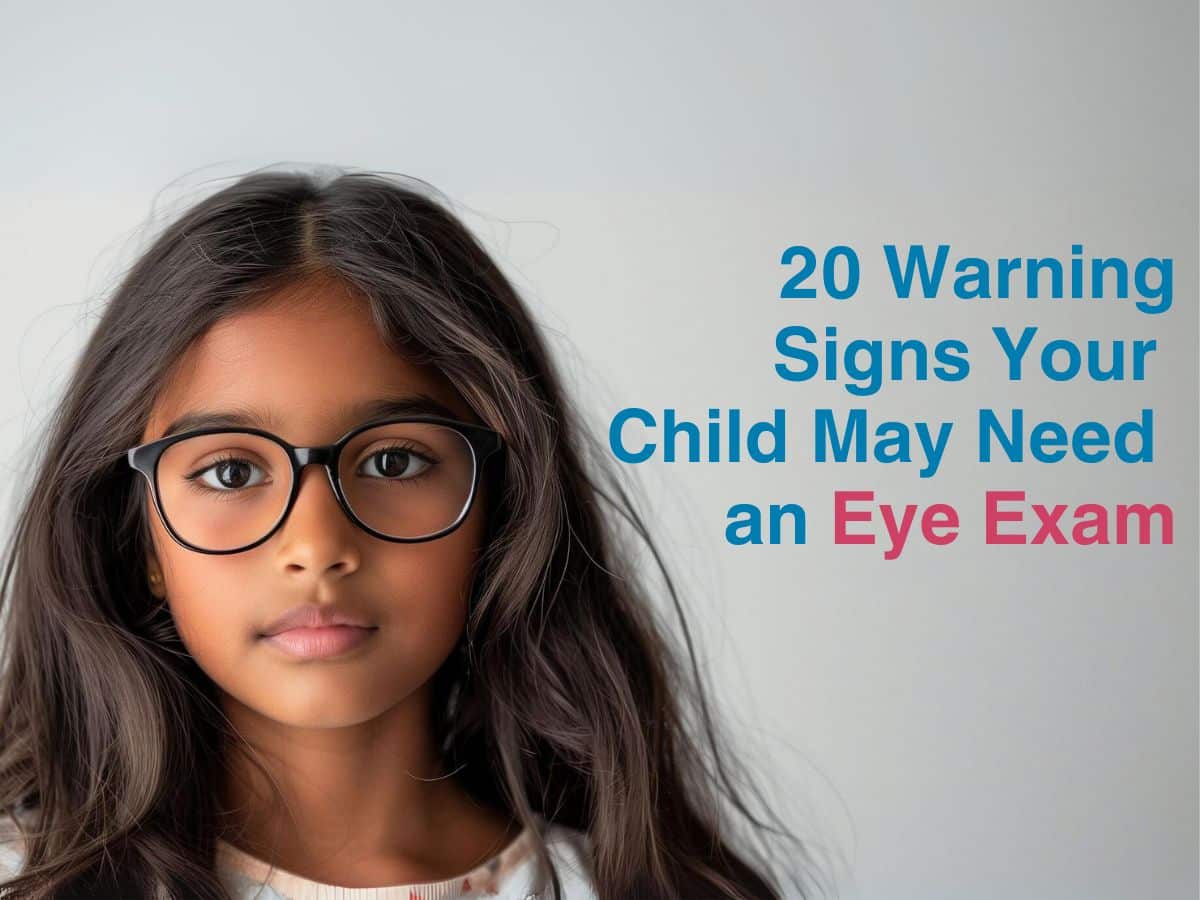
20 Warning Signs Your Child May Need an Eye Exam

Henry David Thoreau rightly said, “The eye is the jewel of the body.”!
As parents, it is natural to want our children to have a great vision to enable their learning and development.
However, children may not always be able to articulate vision problems, so parents and caregivers must recognize potential signs of eye issues.
In this comprehensive guide, we’ll explore the common symptoms and warning signs that indicate your child might need an eye exam.
1. Frequent Eye Rubbing
One of the most noticeable signs of eye strain or fatigue in children is frequent eye rubbing.
Observing your child rubbing their eyes often, especially during or after visual tasks like reading or watching TV, could indicate eye discomfort or vision problems.
2. Squinting
Squinting is a natural response when trying to see something more clearly.
If your child frequently squints while looking at distant objects, watching TV, or reading, it may be a sign they’re having difficulty focusing.
3. Tilting the Head or Covering One Eye
Children with vision problems in one eye may tilt their heads or cover one eye to compensate.
This behavior can indicate a variety of issues, including amblyopia (lazy eye) or strabismus (crossed eyes).
4. Sitting Too Close to Screens
If your child consistently sits very close to the TV or holds books or digital devices unusually close to their face, it could be a sign of nearsightedness (myopia).
5. Difficulty Reading or Avoiding Reading
Children with undetected vision problems may struggle with reading or show a lack of interest in books.
They might lose their place frequently, use a finger to guide their reading or complain that words appear blurry.
6. Frequent Headaches
Headaches, especially after school or extended periods of visual focus, can be a sign of eye strain or uncorrected vision problems.
7. Excessive Blinking
While some blinking is normal, excessive blinking can indicate eye strain or an attempt to clear blurry vision.
8. Poor Hand-Eye Coordination
If your child struggles with activities requiring hand-eye coordination, such as catching a ball or tying shoelaces, it could be due to vision issues.
9. Difficulty Maintaining Eye Contact
Young children who have trouble maintaining eye contact may be experiencing vision problems that make it challenging to focus on faces.
10. Light Sensitivity
Unusual sensitivity to light, especially when outdoors, can be a sign of various eye conditions and should be evaluated by an eye care professional.
11. Watery Eyes
Constantly watery eyes that aren’t caused by emotion or irritants may indicate eye strain or other vision issues.
12. Red or Swollen Eyes
Chronically red or swollen eyes can be a sign of eye infections or allergies, but they can also indicate more serious vision problems.
13. Poor Performance in School
If your child’s academic performance suddenly declines or they have trouble seeing the board in class, it could be due to vision problems.
14. Difficulty Recognizing Familiar People or Objects at a Distance
If your child has trouble recognizing familiar faces or objects from a distance, it may indicate nearsightedness.
15. Holding Objects at Arm’s Length
Just as sitting too close can indicate nearsightedness, holding objects at arm’s length to see them clearly can be a sign of farsightedness (hyperopia).
16. Clumsiness or Frequent Accidents
Children with depth perception issues or other vision problems may appear clumsy or have frequent accidents.
17. Unusual Eye Appearance
Any noticeable changes in the appearance of your child’s eyes, such as a cloudy look, white pupils, or eyes that appear to point in different directions, warrant immediate attention from an eye care professional.
18. Digital Eye Strain Symptoms
With increased screen time, children may experience symptoms of digital eye strain, including dry eyes, blurred vision, and headaches after using digital devices.
19. Family History of Vision Problems
If there’s a family history of eye conditions such as amblyopia, strabismus, or significant refractive errors, your child may be at higher risk and should have regular eye exams.
20. Complaining About Eye Discomfort
While it may seem obvious, it’s important to take your child seriously if they complain about eye discomfort, blurry vision, or seeing double.
When to Schedule an Eye Exam for Your Child
It is often recommended that children have their first eye exam at 6 months of age, another at age 3, and again at 5.
After that, children with normal vision should have an eye exam every two years.
However, if you notice any of the signs mentioned above, it’s important to schedule an appointment with an eye care professional as soon as possible.
Early Detection is Key
Recognizing the early signs of vision problems in children is crucial for their overall development and academic success.
Many eye conditions are more easily treated when caught early, and some vision problems can even be reversed if addressed in time.
Remember, children may not always be able to express that they’re having trouble seeing.
As parents and caregivers, it’s our responsibility to be vigilant and proactive about our children’s eye health.
If you have any concerns about your child’s vision, don’t hesitate to consult with an eye care professional.
Regular eye exams are an essential part of your child’s healthcare routine and can ensure they have the clear vision they need to thrive.
Frequently Asked Questions

Dr. Narahari Yamjala
MS (Ophthalmology)
Head of the Department
Sr. Consultant Cataract & LASIK Surgeon






